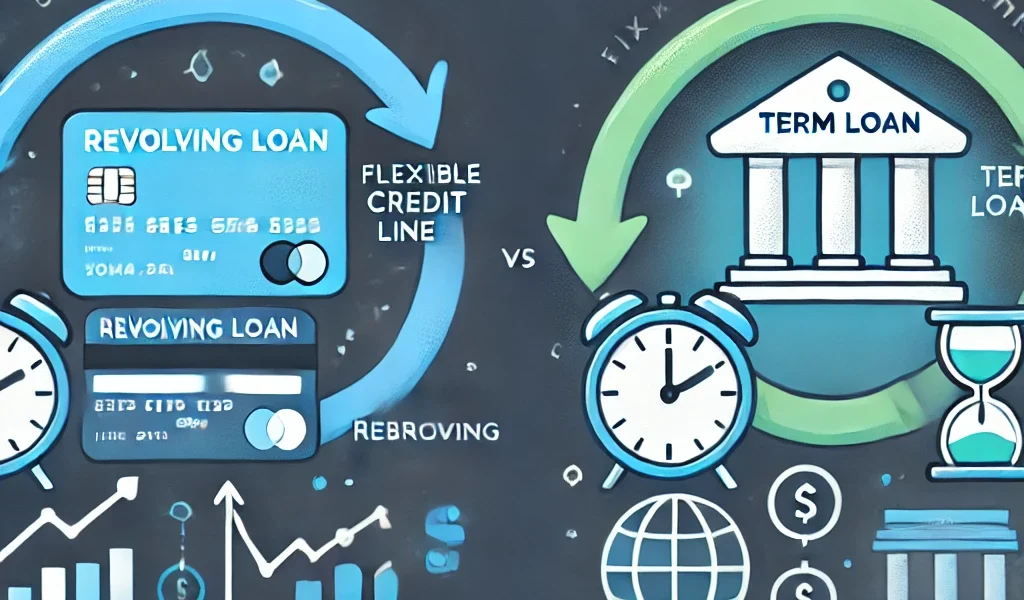Introduction
When seeking financing, businesses and individuals often come across two primary types of loans: revolving loans and term loans. Understanding the differences between these two loan structures is crucial for making informed financial decisions. Each loan type serves different needs and has distinct repayment structures, interest rates, and benefits.
This article explores the key distinctions between revolving and term loans, their pros and cons, and how to choose the right option for your financial situation.
What is a Revolving Loan?
A revolving loan, commonly known as a revolving line of credit, provides borrowers with access to a set amount of funds that they can withdraw, repay, and withdraw again. It functions similarly to a credit card, where funds become available after repayment.
Key Features of Revolving Loans
- Credit Limit: Borrowers receive a maximum limit that they can draw from.
- Flexible Repayment: Monthly payments depend on the amount borrowed and interest accrued.
- Reusability: Once repaid, the funds can be borrowed again without reapplying.
- Variable Interest Rates: Often tied to market rates, causing fluctuations in repayment amounts.
- No Fixed Term: Borrowers can use the loan indefinitely as long as they meet the terms.
Common Types of Revolving Loans
- Credit Cards – Allow ongoing borrowing with minimum monthly payments.
- Home Equity Lines of Credit (HELOCs) – Secured by home equity, offering flexible withdrawals.
- Business Lines of Credit – Provide businesses with working capital as needed.
Pros and Cons of Revolving Loans
Pros: ✅ Flexibility in borrowing and repayment ✅ Can be used multiple times without reapplying ✅ Good for managing short-term financial needs
Cons: ❌ Interest rates can be higher compared to term loans ❌ Risk of overborrowing and debt accumulation ❌ Minimum payments may extend repayment time
What is a Term Loan?
A term loan is a lump sum borrowed upfront that is repaid over a fixed period with scheduled payments. These loans are commonly used for major purchases, business expansion, or long-term investments.
Key Features of Term Loans
- Fixed Loan Amount: Borrowers receive a one-time lump sum.
- Fixed or Variable Interest Rate: Interest rates can be either locked in or fluctuate.
- Structured Repayment: Borrowers make regular payments (monthly, quarterly, or annually).
- Defined Loan Term: The loan must be repaid within a set period (e.g., 5, 10, or 20 years).
Common Types of Term Loans
- Personal Loans – Used for expenses like weddings, home improvements, or medical bills.
- Auto Loans – Finances vehicle purchases over a set term.
- Business Loans – Helps companies finance expansion, equipment, or large projects.
- Mortgage Loans – Home loans with repayment terms ranging from 10 to 30 years.
Pros and Cons of Term Loans
Pros: ✅ Predictable repayment schedule ✅ Lower interest rates compared to revolving loans ✅ Ideal for long-term financial planning
Cons: ❌ Limited flexibility once disbursed ❌ Penalties for early repayment in some cases ❌ Requires a strong credit history and financial stability
Key Differences Between Revolving and Term Loans
| Feature | Revolving Loan | Term Loan |
|---|---|---|
| Loan Amount | Borrow as needed up to a limit | Fixed lump sum |
| Repayment Schedule | Flexible, based on usage | Fixed payments over time |
| Interest Rate | Usually variable | Fixed or variable |
| Best for | Short-term expenses, cash flow management | Long-term investments, large purchases |
| Accessibility | Can reuse funds after repayment | One-time disbursement |
How to Choose the Right Loan for You
Selecting between a revolving and term loan depends on your financial goals, borrowing needs, and repayment ability. Here’s when each loan type is most beneficial:
✅ Choose a Revolving Loan If:
- You need ongoing access to funds.
- You are managing short-term or unexpected expenses.
- You prefer repayment flexibility.
✅ Choose a Term Loan If:
- You need a large lump sum for a specific purpose.
- You want a structured repayment plan with predictable payments.
- You are making a long-term investment or purchase.
Conclusion
Revolving and term loans serve different financial purposes, and choosing the right one depends on your specific needs. Revolving loans offer flexibility and continuous access to funds, making them ideal for short-term financial gaps. Term loans, on the other hand, provide structured repayment schedules and are best for long-term investments.
Before applying for any loan, carefully evaluate your financial situation, interest rates, and repayment capacity to make an informed decision. Consulting a financial advisor or loan officer can also help you select the best loan option for your needs.



